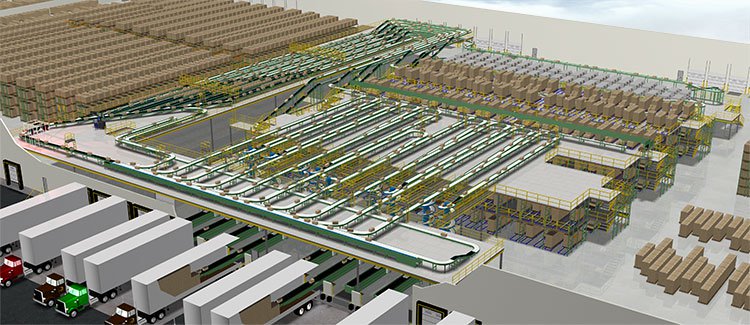Be the Box: Using Visualization to Create a Better Material Handling System Design
Ron Smith | 19 August 2016
When creating your material handling system design, visualizing your product's path and any potential bottlenecks ensures an efficient design that will be successful now and in the future.
We’ve all heard about “visualization” used for things from improving your golf game to shrinking tumors. Not sure if that all works, but believe me, it helps tremendously in my daily job assisting customers. I used to think everyone doing this job automatically did this, but that’s not so. I hope this helps you as much as it has helped me and my customers! Visualization in material handling system design: What do I mean? Where do I apply it? How does it work? What are some benefits? Let’s see…
Visualizing Your Material Handling System Design
When I’m at a customer’s site on the plant floor to help with a material handling, storage, or ergonomic application, I will use creative visualization to “Be the Box”. As I’m listening to the issues, pain points, project details, etc., I will try to picture the entire physical area in my mind and build upon it--exactly like a computer simulation. As the details unfold, I will create a complete mental picture of everything discussed.
Where there are missing details from my imagined solution, I will ask the questions needed to fill in the voids. Join me for an exercise to see how this works and imagine yourself there. In our short example, our customer needs a new path for cases traveling from an existing area to a new area in the facility. So, we find out all the specifications for their boxes and what the existing area looks like, and of course, put that into our mind’s eye. We will now imagine how and where this new line is loaded with actual product in real time.
Next, “see” the boxes moving from that area to the new area, moving at the specified rate and with the right gaps between them. Build and see the new conveyor path in the facility with all the conveyor installed as needed and interfacing with other conveyor and/or machines and the company’s operators. See the box moving between these conveyors and machines and being picked up and set down by operators or robots. See how you will feed a machine. Imagine the path as it curves and changes elevation. Avoid building columns and imagine how the conveyor needs to be supported from the overhead or if you’ll need tall floor supports.
Imagine how this will be installed and with what type of equipment. See the power and air drops coming from the building. That’s a good start! As you build your own simulation right there, you’ll immediately know what you don’t know! As you practice, you will find that it really doesn’t take long to do this. Of course, your tape measure and CAD will help you to refine your layout and guide the final solution. Whether you use a systems integrator, like Bastian Solutions, or design the layout yourself, visualizing product moving through the new system is a good first step at identifying potential problems.
How Visualization Aids in a Better System Design
 In our example, visualization makes it easier to evaluate:
In our example, visualization makes it easier to evaluate:
- How your products will actually travel on conveyor or another solution
- Type of conveyor and equipment needed to perform adequately
- Potential interference along the route
- Transitions from person or machine to conveyor, or conveyor to machine or person, and between conveyors
- Throughput requirements
- Ergonomic and safety issues
In our example, visualization will help you determine:
- Widths and lengths of conveyor required
- Elevations and supports needed
- Type and location of guardrails
- Special components needed
- Installation methods and equipment needed
In our example, visualization will help prevent common problems:
- Conveyor not wide enough for all boxes
- Rollers not on close enough centers
- Missing guard rail or not the right type
- Too much gap between conveyor and machine
- Operators have to reach too high or too low to load or unload conveyor
Visualizing your operation and material handling system might not provide all the answers right away, but taking the time to walk through the process of how your product is handled, provides the opportunity to identify potential issues and solutions. If you’re working with an integrator, the more you understand about your operation, the more you can share and assist in the development of the best material handling system. Visualization is a great tool for systems integrators, but it can also be a helpful tool for warehouse, manufacturing, and distribution center managers. Give it a try, and then give us a call to help you work through the details of a great material handling system.
Comments
No comments have been posted to this Blog Post
Leave a Reply
Your email address will not be published.
Comment
Thank you for your comment.